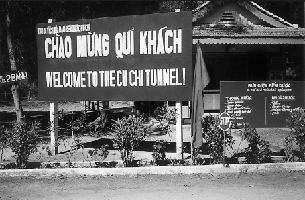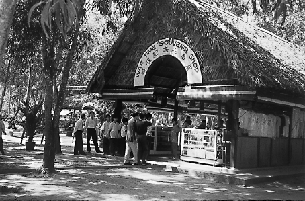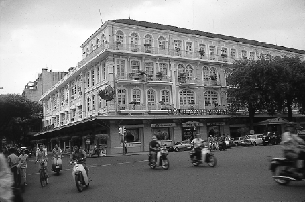THE FACE OF THE “NEW VIETNAM”:
AMENITIES AND ATTRACTIONS
The expertise of the tourism firms lies in their ability to coordinate the logistical aspects of their clients'international journeys, but that can only occur after those travelers have been enticed to the destination by the promise of some desirable experience. As Mowlana notes, it is the task of the tour organizers to “create the experience and image that sells and then proceed to make that the reality for the tourist.”[29] Thus tour operators pay close attention both to the sites that potential travelers might visit and to the literature that will familiarize them with those sites in advance. These can be understood, then, as the negotiated product of the needs and interests of the tourism industry, its clients, and the government that signs contracts to facilitate the industry's success. Because the establishment of Vietnam as a tourist destination for Westerners has occurred within a short period of time and through a rather concerted effort, there is some transparency to tourism's development efforts: they can be viewed as explicitly intended to recreate Vietnam to meet the needs and expectations of potential travelers. It is clear that industry planners seek the attention of business travelers and upscale tourists, particularly those on charter packages from Europe, the United States, or Japan. Development has emphasized historical sites that might appeal to these tourists, the refurbishing or new construction of luxury
The industry anticipated that many of the tourists traveling to the country would be French or American veterans of the war that ended in 1975, returning perhaps to experience Vietnam's beauty in peacetime, to heal the hidden wounds of the war, or to relive certain aspects of that encounter. As one journalist remarked, “Since the end of the Vietnam war, many American films and books have agonized over the meaning of it all. The Vietnamese, who suffered much heavier casualties, … take a more practical approach. They are intent on turning the war into a tourist attraction.”[30]
Indeed, a considerable amount of energy has been invested in constructing monuments around sites that foreign war veterans might want to revisit, and much of that energy has come from domestic sources. These can be differentiated from sites created for ideological purposes by the Vietnamese Communist Party or local cadres for Vietnamese observers, such as the museum-shrine for Ton Duc Thang described in this volume by Christoph Giebel. Sites prepared for foreign tourists were constructed (or reconstructed) later, usually after the official efforts to develop tourism began, suggesting their rather explicit goal of attracting foreign tourists. Further, they are highly commercialized, with souvenir stands and food stalls. And, unlike monuments and shrines used for political and/or ritual purposes of war commemoration by the families of Vietnamese veterans or organized school groups, these sites do not so much bear witness to the war as “trivialize” it, in the sense that George Mosse used that term, “cutting war down to size so that it would become commonplace instead of awesome and frightening … [and] by making it familiar, that which was in one's power to choose and to dominate.”[31]
Turning the war into a tourist attraction means retelling, for profit, the story of Vietnam's victory. Since the profit must come from those who lost the war, aspects of the story must be muted and key roles recast to make the story more palatable. In some instances, the actions taken to mediate and moderate history have been unmistakable. There were, for example, attempts to close the American Rooms of the War Crimes
In other cases, historical reconstruction has been more subtle. Perhaps the best-known of the war sites now opened to tourists are the tunnels at Cu Chi, a network of about 125 miles of underground passageways, built as hideouts, meeting places, bomb shelters, and secret travel routes in southern Vietnam. These tunnels were well-known to U.S. soldiers during the war because of the many dangers associated with them: devoid of light, nearly airless with only the occasional tiny ventilation hole, and built narrow and low to make passage difficult for those with large frames, the tunnels were dreaded by many of those ordered to infiltrate them in search of Viet Cong guerrillas. Today the passages have been enlarged to accommodate Western tourists, and at their entrance a lecture hall, video displays, publicrest rooms, and a souvenir stand have been built (figs. 5.1 and 5.2). In exchange for a few greenbacks, visitors can purchase miniature Huey gunships fashioned out of American soda cans or engraved Zippo lighters like those used to torch entire villages, or they can pick up an M-16 (or an AK-47) and shoot off a round or two of ammunition without fear of return fire. Operated by the Vietnamese army, the tunnels in 1995 attracted up to five hundred visitors a day, served by female guides in black pajamas and rubber sandals— costumes evocative of the Viet Cong.[35] The peculiar reversal of roles between defeater and defeated is unmistakable.
Tan Bien is another reconstructed war site, but it is its former elusiveness rather than familiarity upon which its developers hoped to capitalize. Known by the U.S. Pentagon as COSVN, this secret headquarters of the Viet Cong persistently defied American efforts at destruction. Now, as tourists, Americans are invited back, their hard currency a compelling incentive to disclosure of the secret site. In 1992, work began on

Figure 5.1. Sign at the entrance to the Cu Chi Tunnel complex, Ho Chi Minh City. Photograph by Hue-Tam Ho Tai.

Figure 5.2. War Time Souvenir Shop, Cu Chi Tunnel, Ho Chi Minh City. Photograph by Hue-Tam Ho Tai.
Similar efforts were undertaken to restore the remains of the “MacNamara Line,” an electronic wall of mines once used to keep Communists from entering South Vietnam. The U.S.$2 million project included reconstruction of the blockhouses and bunkers, the observation towers, and the barbed wire, electronic alarms, and odor detectors used to guard the installation. Undertaken by the Vietnamese Ministry of Defense, the site is actually a monument to American technology, complete with literature describing the history and equipment used at the installation, provided at the courtesy of the U.S. government.[37]
Part of the work of the tourism industry is also, however, to encapsulate the wars of 1945–75 as a single historical moment in the nation's long history and to move tourists'attention along to other images and narratives; hence the slogan “Vietnam: A Country, Not a War.” Another significant period in the development of tourism is the French imperialist era, beginning in the middle 1800s. The legacy of French colonial domination is evident in the Impressionist artwork found in Vietnamese museums, in the highland villas built as retreats for colonial officers, and in the architecture of churches, government buildings, and—where tourists would most likely encounter it—in hotels.
In 1990, which was dubbed “Visit Vietnam Year,” one of the notable shortcomings of the industry was the lack of hotel accommodations. Ho Chi Minh City had only thirteen hundred international standard beds, and Hanoi had only eight hundred, about half the number needed to meet the national goal for visitors that year.[38] In both cities, however, work had already begun on noteworthy ventures by hoteliers. In Hanoi, a French hotelier began the restoration and renovation of the Reunification (Thong Nhat) Hotel, which during the French colonial era had been the Hotel Me´tropole. Restoration included not only the classical French colonial architectural motifs of the building and its guest rooms but also the reinstatement of the French name, Hotel Sofitel Me´tropole, in lieu of the Vietnamese. Once work was completed, an advertisement placed in an English-language publication showed a 1930s-era postcard of the hotel and promised “Charme du Passe´ … Aujourd'hui.”
The story of the Reunification Hotel was soon repeated throughout Vietnam. In Ho Chi Minh City, for example, foreign investors renovated

Figure 5.3. The restoration of the Hotel Continental in the heart of Ho Chi Minh City celebrates Vietnam's colonial legacy. Photograph by Laurel Kennedy.
For many wealthy travelers to Vietnam, from both the East and the West, the delight of colonial decadence may itself be a somewhat foreign experience. Many travelers seek more explicitly modern, although culturally anonymous, comforts for their travel experiences: airconditioned suites overlooking expanses of beach, state-of-the-art golf courses and marinas, and the opportunity to shop for souvenirs or duty-free goods. In Ho Chi Minh City, what had formerly been the Four Seasons Hotel on the Australian Great Barrier Reef was relocated by a
The most significant financial investments, however, were in the resort hotels—no more organicto Vietnam than the new discotheques. Outside of Da Nang, in what is once again being called “China Beach,” 536 acres of beachfront and a Soviet-built hotel were purchased by an American firm for U.S.$280 million, for development into a tourist complex of hotels, residential housing for expatriates, a shopping “village,” and a golf course—one of the scores of anonymous resort hotels that continue to be built. In Hue, a Vietnamese-Malaysian joint venture invested U.S.$408 million in new resorts, the renovation of an older hotel, and a tourist center in the middle of the city. By the mid-1990s, a South Korean company was planning a U.S.$290 million resort complex on the Con Dao Islands, once the site of a French colonial prison; five Singaporean partners were considering a U.S.$300 million tourist complex in Da Lat; and Club Med was negotiating to build a resort near Cam Ranh Bay. These developments and others by the Radisson, Marriott, and Choice hotel chains begged the question of whether Vietnam would soon be actually oversupplied with hotel accommodations, particularly the fourand five-star luxury units intended for the wealthiest tourists.